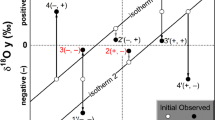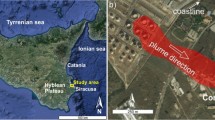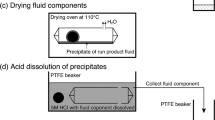Abstract
Reservoir fluid compositions have been assessed from analytical data on water samples collected from thermal and cold waters in Balçova geothermal field. The results of mineral equilibrium modelling indicate that the waters, with some exceptions, are systematically supersaturated with respect to calcite, aragonite, dolomite, chalcedony and quartz, but undersaturated with respect to amorphous silica, celestite, anhydrite and gypsum and undersaturated or supersaturated with respect to barite, low-albite, K-feldspar, gibbsite and Fe(OH)3(a). Calculation of mineral saturation states and geochemical analyses of scale and field observations show that carbonate minerals (calcite, aragonite and dolomite) are most likely to be precipitated as a scale type. Besides carbonates, scale formation risk of amorphous silica, Fe(OH)3(a), anhydrite, barite and celestite minerals should be taken into account in some wells and surface equipment. Most of the waters, with some exceptions, have carbonate scaling risk at all temperatures, whereas the other scaling risks only exist over a limited temperature range. While silica, Fe(OH)3(a) and barite show a scaling tendency at low temperatures, anhydrite and celestite scaling occurs at higher temperatures.







Similar content being viewed by others
References
Aksoy N (2001) Balçova-Narlidere jeotermal sisteminin izleyiciler ile incelenmesi. Ph.D. thesis, Dokuz Eylül University, İzmir, (in Turkish)
APHA (1989) Standard methods for the examination of water and wastewater, 19th edn. American Public Health Association, Washington DC
Arnórsson S (1995) Scaling problems and treatment of separated water before injection. In: WGC–95, book of course on injection technology, International Geothermal Association, Florence, pp 65–77
Arnórsson S (2000) Isotopic and chemical techniques in geothermal exploration, development and use: sampling methods, data handling, interpretation. International Atomic Energy Agency STI/PUB/1086, Vienna
Calmbach L (1997) Aquachem Computer Code—Version 3.7.42. Waterloo, Ontario, Canada, N2L 3L3: Waterloo Hydrogeologic
Çolak M, Gemici Ü, Tarcan G (2003) The effects of colemanite deposits on the arsenic concentrations of soil and groundwater in İğdeköy-Emet, Kütahya, Turkey. Water Air Soil Pollut 149:127–143
Erdoğan B (1990) İzmir-Ankara zonunun İzmir ile Seferihisar arasındaki bölgede stratigrafik özellikleri ve tektonik evrimi. TPJD Bull 1:1–20 (in Turkish)
Gemici Ü, Tarcan G (2002a) Distribution of boron in thermal waters of western Anatolia, Turkey and examples on their environmental impacts. Environ Geol 43:87–98
Gemici Ü, Tarcan G (2002b) Hydrogeochemistry of the Simav geothermal field, western Anatolia, Turkey. J Volcanol Geotherm Res 116:215–233
Gemici Ü, Tarcan G (2004) Hydrogeological and hydrogeochemical features of the heybeli spa, Afyon, Turkey: arsenic and the other contaminants in the thermal waters. Bull Environ Contam Toxicol 72:1107–1114
Gemici Ü, Tarcan G, Çolak M, Helvaci C (2004) Hydrogeochemical and hydrogeological investigations for thermal waters in Emet area (Kütahya–Turkey). Appl Geochem 19:105–117
Gökgöz A, Tarcan G (2006) Mineral equilibria and geothermometry of the Dalaman–Köyceğiz thermal springs, southern Turkey. Appl Geochem 21:253–268
Hepbaşli A, Çanakçi C (2003) Geothermal district heating applications in Turkey: a case study of Izmir–Balçova. Energy Convers Manag 44:1285–1301
Hepbaşli A, Özgener L (2004) Development of geothermal energy utilization in Turkey: a review. Renew Sustain Energy Rev 2:433–460
Parkhurst DL, Appelo CAJ (1999) User’s guide to PHREEQC (version 2)—a computer program for speciation, batch-reaction, one-dimensional transport, and inverse geochemical calculations, U.S. geological survey water-resources investigations report 99-4259
Satman A, Serpen Ü, Onur M (2002) Reservoir and production performance of İzmir Balçova-Narlidere geothermal field. Project Report for Balçova Geothermal Ltd, İzmir (in Turkish)
Serpen Ü (2004) Hydrogeological investigations on Balçova geothermal system in Turkey. Geothermics 33:309–335
Tarcan G (2005) Mineral saturation and scaling tendencies of waters discharged from wells (>150°C) in geothermal areas of Turkey. J Volcanol Geotherm Res 142:263–283
Tarcan G, Gemici Ü (2003) Water geochemistry of the Seferihisar geothermal area, İzmir, Turkey. J Volcanol Geotherm Res 126:225–242
Tarcan G, Gemici Ü (2005) Effects of the contaminants from Turgutlu-Urganli thermomineral waters on the cold ground and surface waters. Bull Environ Contam Toxicol 74:485–492
Tarcan G, Filiz Ş, Gemici Ü (1999) Hydrogeochemical studies and geothermometry applications in Balçova and Seferihisar (İzmir) geothermal fields. Paper presented in 1st symposium of the western Anatolian natural sources, proceeding book, 8–14 March, İzmir, pp 346–358 (in Turkish)
Tarcan G, Gemici Ü, Aksoy N (2005) Hydrogeological and geochemical assessments of the Gediz Graben geothermal areas, western Anatolia, Turkey. Environ Geol 47:523–534
Yilmazer S (1989) Geochemical features of Balçova hot springs and geothermal energy possibilities for the area. Ph.D. thesis, Akdeniz University Graduate School, Isparta, (in Turkish)
Acknowledgments
The authors acknowledge the financial supports of TÜBİTAK Research Fund (project number YDABAG 102Y039) and Balçova Jeotermal Limited Company. Critical reviews by Dr. Dror Avisar (Tel-Aviv University) in an earlier version of this manuscript are gratefully appreciated.
Author information
Authors and Affiliations
Corresponding author
Rights and permissions
About this article
Cite this article
Tarcan, G., Gemici, Ü. & Aksoy, N. Hydrogeochemical factors effecting the scaling problem in Balçova geothermal field, İzmir, Turkey. Environ Geol 58, 1375–1386 (2009). https://doi.org/10.1007/s00254-008-1640-2
Received:
Accepted:
Published:
Issue Date:
DOI: https://doi.org/10.1007/s00254-008-1640-2




